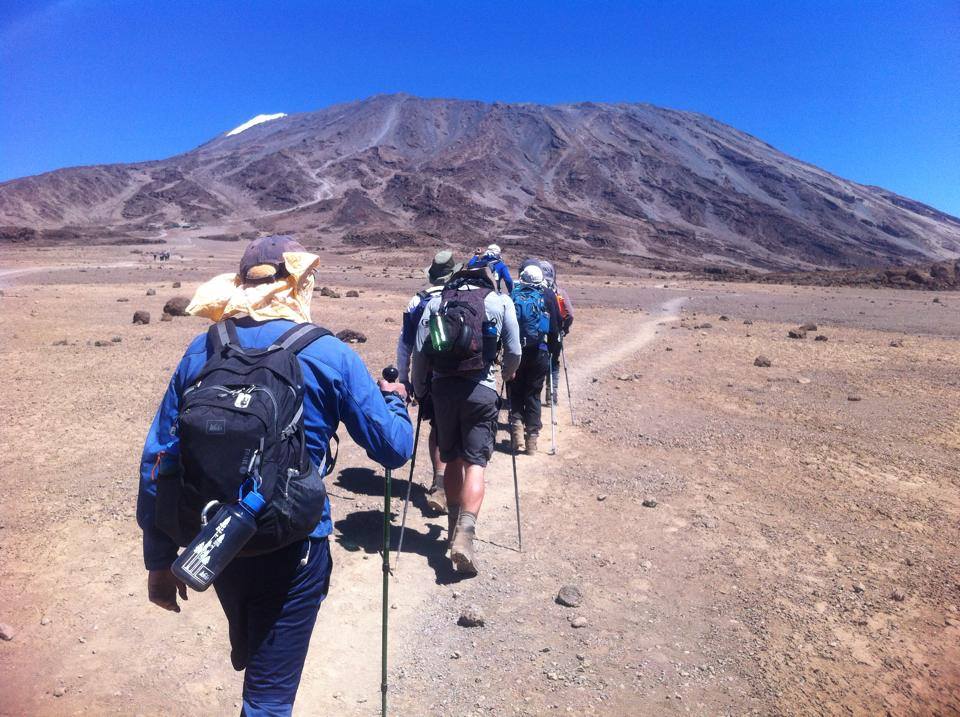What to Expect in Kilimanjaro’s Alpine Desert
trekkers in alpine desert zone on kilimanjaro
When you journey with I Artist Adventure through Kilimanjaro’s fourth climate zone, the alpine desert, you'll find yourself in a truly otherworldly landscape. “It feels like stepping onto another planet,” says our local guide Daniel.
Located between 13,200′ and 16,000′, this zone offers dramatic contrasts: blazing sun during the day, biting cold at night, and wind that carries both dust and silence across the rocky trail.
“The lush rainforest below is unforgettable, the snowy summit thrilling—but the alpine desert is where you begin to feel the full scope of the mountain,” says Daniel.
So why do I Artist Adventure’s mountain experts love this zone so much? “It may seem barren,” says Neema, one of our trekking coordinators, “but it’s in this raw, wide-open space that trekkers connect deeply with their journey. You feel the power of nature and your place in it.”
Here’s what our Kilimanjaro specialists say you can expect in the alpine desert—straight from the trails of Tanzania.
An Alien Environment
rocky landscape of alpine desert on kili
If you saw a photo of this place with no context, you might assume it was a Martian landscape. The alpine desert’s ashy, volcanic terrain reflects Kilimanjaro’s explosive geological history. Yet, despite its rawness, this zone offers a rare sense of calm.
“It’s mostly rock and dust,” says Neema. “From Karanga to Barafu, every footstep echoes with a soft rattle of loose stones. That subtle sound becomes part of the rhythm of your trek.”
The Views Are Astonishingly Gorgeous
The muted tones of the terrain—dusty greys and volcanic browns—are offset by the deep, crystal-blue sky. And when you realize you're walking above the clouds, the view becomes almost surreal.
angela trekking above cloud line in alpine desert zone
view of moshi from karanga camp in alpine desert zone
“The clouds form an endless sea,” says Daniel. “And when they clear, you can see the vast Tanzanian landscape below—Mount Meru, Moshi, and even parts of Arusha. It’s a view few travelers ever get to witness.”
You're Exposed—But With I Artist, You’re Equipped
As you ascend, altitude effects increase. The thinner air means stronger UV rays and drier conditions. Despite cooler temperatures, the alpine desert can feel surprisingly warm during the day.
TIPS from I Artist Adventure
-
Use high-SPF sunscreen on your face and hands
-
Sunglasses are a must at this altitude
-
Bring SPF lip balm to avoid painful cracking
Nights here are cold. After sunset, temperatures can fall into single digits (°C).
TIPS:
-
Layer up for meals—dining tents can be chilly
-
Wear a beanie or thermal hat while you sleep
This zone receives less than 10 inches of rain per year, making it one of the driest places on the mountain. Combined with high wind and strong sun, dehydration can sneak up on you.
TIPS:
-
Hydrate constantly, even if you're not sweating
-
A neck gaiter helps protect against wind and dust
-
Wear gaiters over your boots to prevent gravel and scree from entering
It’s Part of the Journey
trail from karanga to barafu through alpine desert of kilimanjaro
“At first, the landscape may feel repetitive,” says Neema, “but that’s the beauty of it. The alpine desert strips away distractions. All that’s left is you and the summit.”
With every step, the focus sharpens. There are fewer trees, fewer signs of life. And that’s exactly what prepares you mentally for the final push.
view of kibo from alpine desert zone on kilimanjaro
With I Artist Adventure, your trek through this remarkable zone is not just a hike—it’s a transformation. Our expert Tanzanian guides, cultural insight, and deep-rooted respect for Kilimanjaro ensure your journey is as meaningful as it is unforgettable.
Join us in the alpine desert—and discover where the mountain truly begins to speak.
Celebrate the harmony of art and nature in Tanzania!
+255 767 863 986
info@iartistadventure.com
